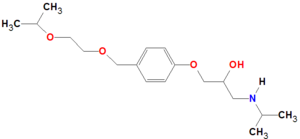Bisoprolol: Difference between revisions
Jump to navigation
Jump to search

imported>Robert Badgett No edit summary |
mNo edit summary |
||
| (2 intermediate revisions by 2 users not shown) | |||
| Line 1: | Line 1: | ||
{{subpages}} | {{subpages}} | ||
{{Chem infobox | |||
|align=right | |||
|image={{Image|Bisoprolol.png|center|300px|Structure of Bisoprolol.}} | |||
|width=300px | |||
|molname=Bisoprolol | |||
|synonyms= | |||
|molformula= C<sub>18</sub>H<sub>31</sub>NO<sub>4</sub> | |||
|molmass= 266.34 | |||
|uses=adrenergic beta-antagonist | |||
|properties= | |||
|hazards= | |||
|iupac= | |||
|casnumber= 66722-44-9 | |||
}} | |||
In [[medicine]], '''bisoprolol''' is a "cardioselective [[adrenergic beta-antagonist|beta-1-adrenergic blocker]]. It is effective in the management of [[hypertension]] and [[angina pectoris]]."<ref>{{MeSH}}</ref> | In [[medicine]], '''bisoprolol''' is a "cardioselective [[adrenergic beta-antagonist|beta-1-adrenergic blocker]]. It is effective in the management of [[hypertension]] and [[angina pectoris]]."<ref>{{MeSH}}</ref> | ||
Variation in the effects of bisoprolol may be due to adrenergic receptor genotypes.<ref name="pmid17585213">{{cite journal |author=Zaugg M, Bestmann L, Wacker J, ''et al'' |title=Adrenergic receptor genotype but not perioperative bisoprolol therapy may determine cardiovascular outcome in at-risk patients undergoing surgery with spinal block: the Swiss Beta Blocker in Spinal Anesthesia (BBSA) study: a double-blinded, placebo-controlled, multicenter trial with 1-year follow-up |journal=Anesthesiology |volume=107 |issue=1 |pages=33–44 |year=2007 |month=July |pmid=17585213 |doi=10.1097/01.anes.0000267530.62344.a4 |url=http://meta.wkhealth.com/pt/pt-core/template-journal/lwwgateway/media/landingpage.htm?an=00000542-200707000-00010 |issn=}}</ref> | Variation in the effects of bisoprolol may be due to adrenergic receptor genotypes.<ref name="pmid17585213">{{cite journal |author=Zaugg M, Bestmann L, Wacker J, ''et al'' |title=Adrenergic receptor genotype but not perioperative bisoprolol therapy may determine cardiovascular outcome in at-risk patients undergoing surgery with spinal block: the Swiss Beta Blocker in Spinal Anesthesia (BBSA) study: a double-blinded, placebo-controlled, multicenter trial with 1-year follow-up |journal=Anesthesiology |volume=107 |issue=1 |pages=33–44 |year=2007 |month=July |pmid=17585213 |doi=10.1097/01.anes.0000267530.62344.a4 |url=http://meta.wkhealth.com/pt/pt-core/template-journal/lwwgateway/media/landingpage.htm?an=00000542-200707000-00010 |issn=}}</ref> | ||
==History== | |||
Bisoprolol fumarate was approved in 1992.<ref>[http://www.accessdata.fda.gov/scripts/cder/drugsatfda/index.cfm?fuseaction=Search.Overview&DrugName=ZEBETA Drugs@FDA]. U S Food and Drug Administration</ref> [[Generic drug|Generic]] bisoprolol was approved in 2002.<ref>[http://www.accessdata.fda.gov/scripts/cder/drugsatfda/index.cfm?fuseaction=Search.Set_Current_Drug&ApplNo=075474&DrugName=BISOPROLOL%20FUMARATE&ActiveIngred=BISOPROLOL%20FUMARATE&SponsorApplicant=MUTUAL%20PHARM&ProductMktStatus=3 Drugs@FDA]. U S Food and Drug Administration</ref> | |||
==Metabolism== | ==Metabolism== | ||
| Line 9: | Line 29: | ||
==Dosage== | ==Dosage== | ||
For healthy adults, the starting dose is 5 mg orally per day (sometimes 2.5 mg) and the maximum dose is 10 to 20 mg orally per day. | For healthy adults, the starting dose is 5 mg orally per day (sometimes 2.5 mg) and the maximum dose is 10 to 20 mg orally per day. | ||
== Synoyms and Brand Names == | |||
''Synonyms'' | |||
* bisoprolol fumarate | |||
* bisoprolol hemifumarate | |||
* bisoprolol fumerate | |||
''Brand Names'' | |||
*Cardicor | |||
*Concor | |||
*Condyline | |||
*Condylox | |||
*Detensiel | |||
*Emconcor | |||
*Emcor | |||
*Euradal | |||
*Isoten | |||
*Monocor | |||
*Soloc | |||
*Soprol | |||
*Zebeta | |||
==External links== | ==External links== | ||
| Line 14: | Line 57: | ||
==References== | ==References== | ||
<references/> | <references/>[[Category:Suggestion Bot Tag]] | ||
Latest revision as of 06:01, 19 July 2024
|
| |||||||
| Bisoprolol | |||||||
| |||||||
| Uses: | adrenergic beta-antagonist | ||||||
| Properties: | |||||||
| Hazards: | |||||||
| |||||||
In medicine, bisoprolol is a "cardioselective beta-1-adrenergic blocker. It is effective in the management of hypertension and angina pectoris."[1]
Variation in the effects of bisoprolol may be due to adrenergic receptor genotypes.[2]
History
Bisoprolol fumarate was approved in 1992.[3] Generic bisoprolol was approved in 2002.[4]
Metabolism
It is not metabolized by cytochrome P-450 2D6 allele.
Dosage
For healthy adults, the starting dose is 5 mg orally per day (sometimes 2.5 mg) and the maximum dose is 10 to 20 mg orally per day.
Synoyms and Brand Names
Synonyms
- bisoprolol fumarate
- bisoprolol hemifumarate
- bisoprolol fumerate
Brand Names
- Cardicor
- Concor
- Condyline
- Condylox
- Detensiel
- Emconcor
- Emcor
- Euradal
- Isoten
- Monocor
- Soloc
- Soprol
- Zebeta
External links
The most up-to-date information about Bisoprolol and other drugs can be found at the following sites.
- Bisoprolol - FDA approved drug information (drug label) from DailyMed (U.S. National Library of Medicine).
- Bisoprolol - Drug information for consumers from MedlinePlus (U.S. National Library of Medicine).
- Bisoprolol - Detailed information from DrugBank.
References
- ↑ Anonymous (2024), Bisoprolol (English). Medical Subject Headings. U.S. National Library of Medicine.
- ↑ Zaugg M, Bestmann L, Wacker J, et al (July 2007). "Adrenergic receptor genotype but not perioperative bisoprolol therapy may determine cardiovascular outcome in at-risk patients undergoing surgery with spinal block: the Swiss Beta Blocker in Spinal Anesthesia (BBSA) study: a double-blinded, placebo-controlled, multicenter trial with 1-year follow-up". Anesthesiology 107 (1): 33–44. DOI:10.1097/01.anes.0000267530.62344.a4. PMID 17585213. Research Blogging.
- ↑ Drugs@FDA. U S Food and Drug Administration
- ↑ Drugs@FDA. U S Food and Drug Administration
